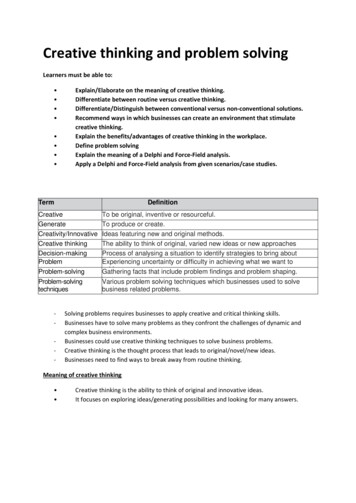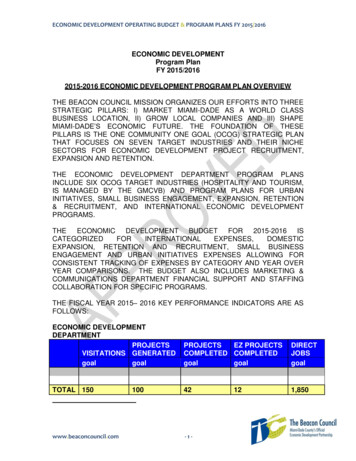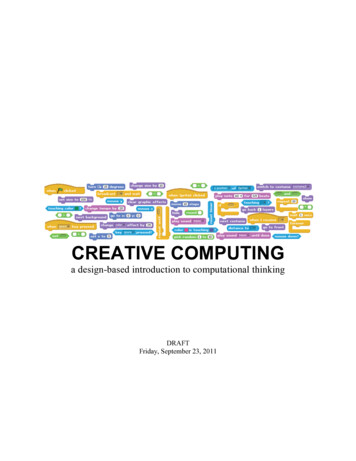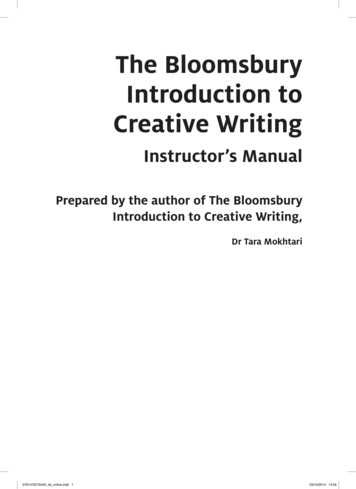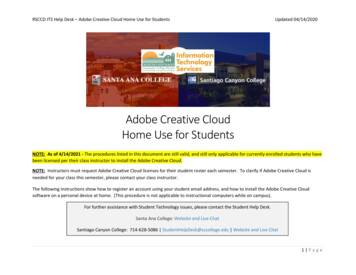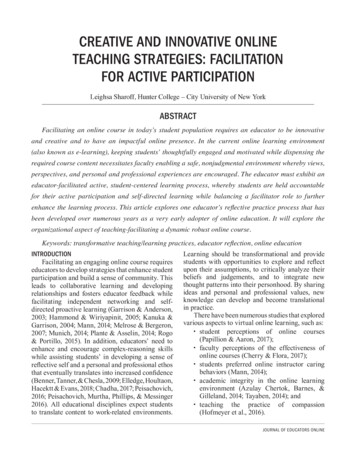
Transcription
CREATIVE AND INNOVATIVE ONLINETEACHING STRATEGIES: FACILITATIONFOR ACTIVE PARTICIPATIONLeighsa Sharoff, Hunter College – City University of New YorkABSTRACTFacilitating an online course in today’s student population requires an educator to be innovativeand creative and to have an impactful online presence. In the current online learning environment(also known as e-learning), keeping students’ thoughtfully engaged and motivated while dispensing therequired course content necessitates faculty enabling a safe, nonjudgmental environment whereby views,perspectives, and personal and professional experiences are encouraged. The educator must exhibit aneducator-facilitated active, student-centered learning process, whereby students are held accountablefor their active participation and self-directed learning while balancing a facilitator role to furtherenhance the learning process. This article explores one educator’s reflective practice process that hasbeen developed over numerous years as a very early adopter of online education. It will explore theorganizational aspect of teaching-facilitating a dynamic robust online course.Keywords: transformative teaching/learning practices, educator reflection, online educationINTRODUCTIONFacilitating an engaging online course requireseducators to develop strategies that enhance studentparticipation and build a sense of community. Thisleads to collaborative learning and developingrelationships and fosters educator feedback whilefacilitating independent networking and selfdirected proactive learning (Garrison & Anderson,2003; Hammond & Wiriyapinit, 2005; Kanuka &Garrison, 2004; Mann, 2014; Melrose & Bergeron,2007; Munich, 2014; Plante & Asselin, 2014; Rogo& Portillo, 2015). In addition, educators’ need toenhance and encourage complex-reasoning skillswhile assisting students’ in developing a sense ofreflective self and a personal and professional ethosthat eventually translates into increased confidence(Benner, Tanner, & Chesla, 2009; Elledge, Houltaon,Hacektt & Evans, 2018; Chadha, 2017; Peisachovich,2016; Peisachovich, Murtha, Phillips, & Messinger2016). All educational disciplines expect studentsto translate content to work-related environments.Learning should be transformational and providestudents with opportunities to explore and reflectupon their assumptions, to critically analyze theirbeliefs and judgements, and to integrate newthought patterns into their personhood. By sharingideas and personal and professional values, newknowledge can develop and become translationalin practice.There have been numerous studies that exploredvarious aspects to virtual online learning, such as: studentperceptions of online courses(Papillion & Aaron, 2017); faculty perceptions of the effectiveness ofonline courses (Cherry & Flora, 2017); students preferred online instructor caringbehaviors (Mann, 2014); academic integrity in the online learningenvironment (Azulay Chertok, Barnes, &Gilleland, 2014; Tayaben, 2014); and teachingthe practice of compassion(Hofmeyer et al., 2016).JOURNAL OF EDUCATORS ONLINE
Faculty development is needed to furtherenhance the integration of e-learning. Not only dostudents need to be aware of the time commitmentand comfortable with technology, but faculty needto be educated regarding the pedagogical methodsappropriate for an online course (Kowalczyk,2014). Faculty members and programs that utilizee-learning need to be cognizant that the educators’online presence is essential to fully disseminatethe course content and that prompt and frequentfeedback and faculty interactions are vital, as isdetailed guidance to students’ questions regardingassignments and course process (Gaudine &Moralejo, 2011; Mann, 2014). Collaborating withstudents in discussions and encouraging peer-topeer collaboration is an important feature to anengaged virtual learning dynamic. Peer interactivedesign promotes collaboration and facilitates asense of community (Chadha, 2017). Attention todetail and clarity of the course, the syllabus, andthe criteria to succeed is mandatory. For a studentto accomplish course objectives and outcomes,faculty need to be organized and structured intheir online content development, and they needto establish clear and defined deadlines andparticipation and course expectations. Otherwise,students may perceive their online learning to beless than they would if they took the course faceto-face in a classroom (Gaudine & Moralejo, 2011).The outcomes of the instructional design process(Baker, 2010; Kim & Hannafin, 2011), as definedby the educator, who dictates the interaction andengagement with the students while promotingregular communication, are essential to facilitateonline teaching-learning success (Carter, Hanna,& Warry, 2016). And as with all learning outcomesand course assessment, measurement is based onthe university’s evaluations.Faculty need to expand their educationalprocesses to integrate technology as a tool and notas a pedagogical methodology. There needs to bea focus on providing quality educational learningexperiences for students while integrating onlineeducational design practices (Kowalczyk, 2014).As in any classroom environment, the educators’awareness of diverse types of learning styles isimportant and even more so with online learning.Varying the learning strategies can be an effectivetool to providing a broad base for different learningstyles. Typically, an online course is asynchronous,JOURNAL OF EDUCATORS ONLINEyet it may have aspects of synchronous real-timeinterfaces, such as specific deadlines for assignmentsand engagement, online quizzes/examinations, andspecific content pertaining to weekly discussion.Varying this flexibility of online teaching activitiesby blending these defined strategies can be helpfulin promoting learning outcomes and experiences.This article discusses the process of one educatorwho was an early adopter of online teaching. Itspurpose is to provide an overview of this educator’sexperience, process, teaching style, and creativediverse teaching/learning practices that have led tosuccessful online participation. By incorporatingproactive and collaborative pedagogical practices,students’ engagement, motivation, commitment,and “reflection, knowledge acquisition” isencouraged and supported, thus nurturing thelearning process (Freeman et al., 2014; Peisachovichet al., 2016, p. 114).TEMPLATE FOR ONLINE COURSESA detailed learning design process, withvarious active learning activities leading tostudent engagement and development of currentideas, skills and knowledge, is the challenge forall educators. Developing an e-learning coursethat does not overwhelm students but providesthem with opportunities to glean the essence ofthe material and internalize the knowledge toeventually translate that knowledge to practice isthe ultimate outcome. To achieve this outcome,an effective design and implementation of thelearning process to promote and inspire positiveexperiences for the student, and educator, isfundamental (Carter et al., 2016).As a nurse educator, this author has taught avariety of courses, beginning with the typical brickand mortar classroom. Flipping the classroom to theonline community over a decade ago prompted thisauthor to begin developing virtual course templateprocesses. With each passing semester, designand implementation of the e-learning templatebecame more detailed, tailored, and structured.Needless to say, this educators’ learning curvewas steep in the beginning as an early adopter ofonline teaching. With over a decade of revising,refining, and organizing an instructional teachingprocess for virtual facilitation, a template wassuccessfully developed. This author has utilizedthis e-learning template in a variety of courses,
such as a prelicensure baccalaureate nursingcourse in Women’s Health, a graduate course inTherapeutic Counseling Modalities: AdvancedNursing Perspectives and Practice for psychiatricmental health nurse practitioner students, and agraduate/Doctor of Nursing Practice course inClinical Genetics.Educator’s Experiences and Learning CurvesOne of the first learning curves was redesigningthe syllabus. An online course syllabus requiresmore details, instruction, and structure. Theauthor learned that repeating information in thesyllabus and with online platform applicationannouncements helped to organize the course forsuccessful student outcomes. Being extremelyclear on the required assignment deadlines, tothe exact minute that an assignment would beconsidered late, was essential. It is necessary forthe educator, as well as the student, to be able toadapt to expected and unexpected situations thatmay arise throughout a course. Yet, having clearlydefined criteria and expectations are the groundwork for achieving success. Transparency in anyenvironment is paramount to provide guidanceregarding assignments, learning activities arebriefly discussed in the syllabus with extensivematerial posted on the learning platform.In addition to mandated inclusion contentper university policy and procedures, providingcomprehensive information pertaining to onlineexamination, such as tips for taking an online exam,helps students to prepare in advance by testingtheir browser compatibility and computer skills.This is obvious for technologically savvy studentsin undergraduate education courses; however,advanced degree students or nontraditional studentsrequire additional information to alleviate anxietywith an e-learning format. Tips such as rebooting/restarting their computer before taking theexamination has shown to be effective in helpingstudents to close numerous browser webpages.Also, inform students in advance about little quirksof online testing. For example, if a question asksfor a numerical answer, use the actual numberand do not spell out the number, such as 50, notfifty, as fifty will be marked incorrect. And donot put any other descriptor, such as % sign nextto answer, as 50% will also be marked incorrectly.As the educator who has reviewed countless onlineexaminations, informing students in advanceof these quirks has decreased stress for both thestudent and the educator.Development of An Online CourseThe online community.Based on the university’s learning platform,designing the online community is essentialfor student success. At this authors’ university,Blackboard is the educational learning m would provide the same functions. Anentire semester of content must be disseminatedvia e-learning that promotes critical thinking,reflection, and active participation, and thatthoughtfully engages collaborative learning. Thisis a tall order for any educator, hence the need for astructured course development process. Organizingthe course in advance deters from last minutedistractions for the educator. Setting up virtualoffice hours, implementing the 24- to 48-hour ruleof responding to email for students and educator,and providing as much clarity and transparency ofcourse requirements and criteria for success areextremely positive steps for all involved. Regularcommunication via announcements and classemails provides more guidance and keeps studentson track for weekly expectations and course criteriathat needs to be met.Keeping a community in a large class.This author has facilitated online coursesranging from 7 to 119 students and the process forgroup dynamics remains the same. Group dynamicsare a part of all relationships, which is why groupingfive to seven students in each group is sufficient tohave a thoughtful and engaged dialogue. Groupingtogether fewer than five students does not promotea robust discussion while more than seven tends tolead to an overwhelming experience. An educatorneeds to know what works for their course andcontent and how to assist students to glean theknowledge that the class is presenting. Over yearsof experience with online teaching, this author hasgrouped students in a variety of manners, rangingfrom 5 to 10 students. To allow for a natural organicflow of students’ dialogue, 5–7 students proved thebest for active, deliberative peer discussions witheducator facilitation while coproducing contentwithin the group discussion. The larger the group,the more arduous it was for students and educatorto fully engage with each other. An e-learningJOURNAL OF EDUCATORS ONLINE
collaborative course with student interactiveengagement promotes reflective peer discussionsto meet the envisioned pedagogical learning needsand outcomes for any course (Chadha, 2017). Oneof the fascinating aspects of online teaching is theminimization of the quiet student who typicallywould not engage in a face-to-face classroomdynamic. Shy, quiet students are obligated toengage in a group discussion. There will alwaysbe dominant voices online, but e-learning hasprovided a venue for the quieter student to voicehis/her opinion, thoughts, and ethos. The authorof this paper has tried two ways of structuringgroups, either allowing students to form theirown groups or randomly assigning students toa group. Each process has its own merits, but,after experimenting with these two processes, theauthor believes that randomly assigning studentsto a group is more beneficial. The rationale forrandom selection of students is that it facilitatesmeeting different people that students may nottypically engage with provides a wider range ofinsight (as friends characteristically have similarbeliefs and philosophies) and permits for enhancedgroup diversity (such as culturally, intellectually,dominant vs quiet voices). As an example, the authorallowed a cohort of prelicensure baccalaureatenursing students [119 students] to preselect theirgroupmates. At the end of the semester, the studentswere asked if they would have preferred beingrandomly assigned to a group. Interestingly, themajority of students said they would have preferredbeing assigned, commenting that they stayed ingroups with their friends and felt that if they havediversified, they would probably have gained moreinsight into the topics discussed.Another strategy for communal building isa concept that this author refers to as “questionsfrom a colleague.” Within the first several weeksof an online course, the author requests thatgroupmates first ask each other for assistance inclarifying any questions. When a student requiresfurther clarification, the author posts the questionon the learning platform announcement page witha subject heading of “question from a colleague.”The assumption from this educator is that if onestudent has this question, then others do as well.The question (without the name of the student)and the answer are posted for the community tolearn from.JOURNAL OF EDUCATORS ONLINELearning ModulesWeekly content is organized into individuallearning modules (under Course Materials, forexample) with a title for that module that correlates tothe syllabus week. This educator learned that titlingthe weekly learning module to the syllabus providedadditional organization. Considering the variouslearning styles of students, repetition is a beneficialtool. Labeling a learning module Week 11 does notprovide the same clarity, and intellectual connectionto content, as Week 11: Psychopharmacology andPsychotherapy. As shown in Figure 1, within eachweekly learning module there are numerous itemsand files pertaining to the topic (Screen Captureof Module Week 11—Psychopharmacology andPsychotherapy). PowerPoint presentations cannot beFigure 1. Screen Capture of Module Week 11- Psychopharmacologyand Psychotherapyconsidered the sole teaching apparatus, as they tendto disengage students (Peisachovich et al., 2016).However, providing PowerPoints presentations stillholds merit as a teaching tool for dispensing the basicmaterial to be covered. In addition to PowerPoints,social media platforms, such as YouTube and TedTalk, are useful apparatuses for synthesizing anddistributing information to students that enhanceexperiential learning and facilitate further insightinto the topic (Green & Hope, 2010; Sharoff, 2011).Utilizing voice thread and screen capture provideadditional learning strategies, and uploadingexemplary articles and resources adds to the depthof disseminating knowledge. As all educators areaware, tapping into various learning styles andresources is essential to help students successfullyachieve the learning outcomes.
Online Group ForumsFor each group, the author created separateforums, and within each forum, created twoindividual threads: Answers and Discussion, asshown in Figure 2 (Screen Capture of a GroupDiscussion Board). The recommendation to haveFigure 2. Screen Capture of a Group Discussion Board Pagetwo separate threads to further organize the processwas suggested by a student in the authors graduateClinical Genetics course. For each individualweek, the author developed specific facilitatedguided questions based on the content. Students areexpected to submit their individual answers underthe Answer thread. For example, class begins onSunday at midnight and answers are due by Mondayat noon. Submitting answers before or after thestated deadline results in a Final Discussion Board(DB) point deduction. The authors’ experiencehas demonstrated that if students submit early, alevel of competition develops within the group. Astudent who always submits late is referred as ahabitual late responder. In either event, a weeklypoint deduction will ensue based on the criteriadeveloped. This process allows students at alllevels to learn accountability and responsibility fortheir actions and consequences. The Discussionthread is utilized for the general discourse of thematerial. Students are expected to read the answersby their groupmates and a discussion to examinethe material in a deeper manner begins. Thediscussion aspect routinely begins no later thanMonday midnight and continues through Thursday11:59 p.m. As the course facilitator, the author hasaccess to all the groups. As such, the author willpost additional questions to further the discussion,which allows the groups to organically progressin their own way and gently guides them to makecertain that aspects of the content are explored fora deeper understanding. Students are informed viathe syllabus that in the Group DB they should notcreate additional threads to the discussion. In otherwords, they create their own thread in Answerswhen uploading them but reply when in the GroupDB (shown in Figure 2). This process allows foran even flow of discussion without having toclick in and out to read responses. Furthermore,as course facilitator, noting the date and time astudent responds permits the author to determineif a student is a habitual late responder. Per DBPoint Deduction Criteria, a student can lose pointsoff their Final DB grade if they are habitual lateresponders, they post all their responses on the lastday of the content week, or they embed responses.Finally, an important aspect to teaching online,which the author of this paper had to learn, is theloophole of students not completing the work butpassing assignments. As such, every e-learningsyllabus for this author clearly states that studentsmust achieve the equivalent of a “C” or70% in your Final Group DiscussionBoard grade to receive a passing grade inthis class. Meaning, the Final DiscussionBoard grade must be 70 or better to passthis class. Students will automaticallyreceive an F for the course if they fail theDiscussion Board aspect.Through trial and error, this educator hasbecome aware of the many loopholes of learningFigure 3. Screen Capture of Module Week 12JOURNAL OF EDUCATORS ONLINE
to teach online (Figure 2; Figure 4, Excerpt from aSyllabus; and Figure 5, Screen Capture of CourseInformation).Figure 4. Screen Capture of Course InformationFigure 4. Excerpt from a Syllabus Regarding Discussion Board ParticipationClass & Weekly Blackboard Case-Based/Practice QuestionParticipation (50%)Activity on discussion board and interactive learning activities. Eachweek’s discussion board {DB} will be graded and the cumulative gradewill be the 50% for activity on discussion board and interactive learningactivities. You are expected to answer ALL the DB questions.[Per Rubric: you must have a minimum of 3 DB postings, which DOES NOTinclude your answers to the DB questions. REVIEW RUBRIC FOR POINTDEDUCTION CRITERIAPlease Keep to the Schedule of Classes this way, we are all on the samecontent topics together.Each group will engage in their online discussion [in their GroupDiscussion Board]. All answers are to be uploaded in the threadmarked ‘Answers’. The Discussion aspect goes in the thread marked‘Discussion’. Remember, your Answers must be uploaded betweenSunday 12midnight through Monday 12noon. The first person who goesinto that Content Week should create a thread for ‘Answers’ and aseparate thread for ‘Discussion’.Summaries of each week’s Group Discussion must be uploaded by theFriday of that week, by 12pm please in the Class DB. Please put yourGroup Number in the Subject Heading. I suggest that you decide on whowill be the Group Leader [GL] for each individual week. If the Summaryis not uploaded between 12midnight and 12non on the Friday of thatcontent week, then that Group Leader will receive a 5-point deductionfrom their overall Final Discussion Board grade. Thereafter, the entiregroup will receive a 1-point deduction for each day that the summaryis late.The week’s summary should be a clear, concise and succinct overviewof what your group discussed based on that weeks’ content, includingbut not limited to the YouTube videos, Case study assignments and anyJOURNAL OF EDUCATORS ONLINEother reflective aspects.Remember, it’s the Quality, not the Quantity of your postings. However,you must have a minimum of 3 postings in the Discussion Thread. InitialAnswers should be uploaded in the Thread marked: Answers. Answersare to be uploaded between Sunday 12midnight through Monday until12pm of the beginning of the content week. Online discussion shouldbe in the Thread marked: Discussion. The Content Week’s discussionconcludes on Thursday 11:59pm. Summaries are due on Friday by 12pmin the Class Discussion Board, with the Group # in the Subject Heading.Finally, everyone is expected to read and comment on the other groups’discussion board summaries under Class Discussion Board. You do nothave to comment on every group for each summary, you are expectedto make at least ONE comment. If you do not participate in this aspect ofthe class, then 5 points will be deducted for not commenting on GroupSummaries. This is an integral part of our dialogue, as this is how wewill learn what our colleagues were discussing in their individualgroups. This aspect of the course brings us back together as a learningcommunity, this way, we can fully glean what all our colleagues weresaying.Do Not upload a word document for our weekly discussions, please cut/paste your weekly DB answers and summary so everyone can easilyread itPlease refer to Discussion Board Weekly Topics handout on BB for theCase Study Project, you must upload your individual assignment as aWord Doc. This is the only assignment that can be uploaded as a WordDoc [your case study paper, not your summary].You must achieve the equivalent of a “C” or 70% in your Final GroupDiscussion Board grade to receive a passing grade in this class.Meaning, your Final Discussion Board grade must be 70 or better to passthis class. You will automatically receive an F for this course if you failthe Discussion Board aspect.Discussion Board Rubric Evaluation – please see Blackboard/RubricsBringing a virtual class back together as acommunity requires creative thinking on the partof the educator. This author requires each group todecide on their own who will be a Group Leader(GL) for each week. That individual is expected toprovide a clear, concise summary of the group’sweekly discussion with the group number in thesubject heading and post that on the Class DiscussionBoard between Friday midnight and noon. Thisis an important aspect as it brings the class backtogether as whole after being separated into theirindividual groups. Every student is expected toread and submit at least one comment on anothergroups’ discussion board summary under ClassDiscussion Board. It is integral for an online courseto unite students as a learning community so theclass as a whole can fully understand what theircolleagues were discussing. As noted in Figure 2,the first forum is Hello and Welcome, which is a
forum for groupmates to organize their GL rolesand share contact information.ResourcesProviding an abundance of online resourcesgives students an avenue to further explore thematerial. From this authors’ experience, studentstend to explore on their own and forward links forarticles and additional web-based resources. Asthe facilitator of the course, I post these studentfound resources (once legitimacy and relevanceto the course are verified) in an announcementacknowledging the student with a subject heading“shared by a colleague.” This further promotes anactive collaborative learning process. Resourcesspecific to weekly content (including articles,mashups, weblinks, video links, and Flickrphotos) are uploaded in the corresponding module.Generalized resources for the course are uploadedat the beginning of the semester to allow studentsto peruse them on their own time, as can be seen inFigure 5 (Screen Capture of Course Resources forGraduate Clinical Genetics).Figure 5. Screen Capture of Course Resources for Graduate Clinical GeneticsEDUCATOR REFLECTIVE PROCESSThe overall objective of online education isthe same for face-to-face didactic methodology:provide students with an excitement to learn,engage, and seek knowledge. Unique issues arisewith online learning that require the educator tobe creative and innovative in meeting pedagogicalobjectives and outcomes. Creating individual andgroup assignments can be a successful integrationthat assists students to learn both independently andcollaboratively. The course content orchestratesthe type of assignments with majority of work inan e-learning course being independent with aninfusion of collaboration. Individual completion ofwork assignments allows students to learn at theirown pace, while the discussion helps to further theunderstanding of the material by a sharing insightsand viewpoints.Not only is it important for students to receiveinstructor feedback, but as the online facilitator,it is essential to learn what most hinders and/orenhances the learning process to be able to continueto improve the teaching-learning collaboration.Asking students to provide feedback, not justin the basic summative teacher evaluation butin a formative suggestion for enhancement andimprovement, is worthwhile. The author of thispaper has received plentiful feedback, usually onthe structure of the online course, such as: “I like theway you structure the class and your involvement,”while another student wrote:I just wanted to tell you that I really haveenjoyed being part of your class and have gatheredknowledge that will help me in my future classes.I have also seen that you have asked for feedback,so I think that what helped me learn the most waswhen you would connect what we were learning inclass to your own experiences as a nurse.Giving students an opportunity to share theirthoughts can provide valuable insight into howone educates and continues to grow professionally.Student feedback regarding this authors’ onlineclass process has encouraged this authors’ continueddevelopment of e-learning courses. Given thepositive feedback this author has received, not onlyhave the learning outcomes been achieved but thecontinuation of enhancing e-learning promotes thecollaborative engagement that this author has setout to achieve. Meeting students’ learning needs,through creative and innovative teaching/learningpedagogical processes, is the goal of any educator.Being able to have an active presence, guidestudents through the learning process, and enhancetheir comprehension of the content while fosteringa sense of proactive and student-centered learningis the true essence of teaching. Committing to thisideal in an online course requires organization,structure, clearly defined boundaries, andtransparent criteria for students to achieve success.JOURNAL OF EDUCATORS ONLINE
REFERENCESAtack, L. (2003). Becoming a web-based learner: Registerednurses’ experiences. Journal of Advanced Nursing, 44(3),289–297. doi:10.1046/j.1365-2648.2003.02804.xAzulay Chertok, R., Barnes, E., & Gilleland, D. (2014). Academicintegrity in the online learning environment for health sciencesstudents. Nurse Education Today, 34(10), 1324–1329.doi:10.1016/j.nedt.2013.06.002Baker, R. (2010). Examples of scaffolding and chunking in onlineand blended learning environments. Social Science ResearchNetwork. doi:10.2139/ssrn.1608133Benner, P., Tanner, C., & Chesla, C. (2009). Expertise in nursing:Caring, clinical judgment and ethics (2nd Ed.). New York, NY:Springer.Carter, L., Hanna, M., & Warry, W. (2016). Perceptions of theimpact of online learning as a distance-based learning modelon the professional practices of working nurses in NorthernOntario. Canadian Journal of Learning and Technology,42(3),doi:10.21432/T2Q90MChadha, A. (2017). Comparing student reflectiveness in onlinediscussion forums across modes of Instruction and levels ofcourses. Journal of Educators Online, 14(2). Retrieved dfCherry, S., & Flora, B. (2017). Radiography faculty engagedin online education: Perceptions of effectiveness,satisfaction, and technological self-efficiency. RadiologicalTechnology,88(3), 249–262.Elledge, R., Houlton, S., Hackett, S., & Evans, M. J. (2018). “Flippedclassrooms” in training in maxillofacial Surgery: Preparationbefore the traditional didactic lecture? British Journal of Oraland Maxillofacial Surgery, 56(5):
TEACHING STRATEGIES: FACILITATION FOR ACTIVE PARTICIPATION Leighsa Sharoff, Hunter College – City University of New York ABSTRACT Facilitating an online course in today’s student population requires an educator to be innovative and creative and to have an impactful on


